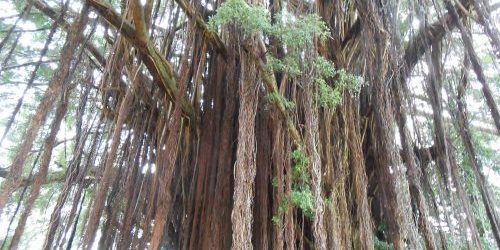Kids Nature Shows Teachers Guide to the Rainforest Show
This guide provides materials that will aid students in getting the best out of the Kids Nature Shows Rainforest program, and includes rainforest facts, vocabulary, and activities and additional resources.
Rainforest Show Overview:
Tropical rainforests are the most biologically diverse terrestrial ecosystems on our planet. More species of trees, plants, insects, reptiles, birds and other animals are found in tropical rainforests than any other habitat.
In this program, we will meet a variety of animal puppets that live in tropical rainforests and find out how each animal is adapted to this habitat. We will also discover how the rainforest is divided into layers and learn how animals survive in these different layers. We will learn why tropical rainforests are important for animals and for people too!
Below are some of the animal puppets you might meet during this program:
Lento the Sloth

Scarlet O’Parrot

Garcia the Iguana

Tommy the Tadpole

Trouble the Tegu

Coco the Crocodile

Bianca the Boa

Vocabulary words you might hear during the Rainforest Show:
- Adaptation: characteristics and behaviors that help an animal or plant survive
- Amphibian: ectothermic, vertebrate animals (frogs, salamanders & caecilians) that typically have moist, slimy skin, usuallylay jelly-like eggs in water, and go through metamorphosis to become adults
- Buttress Roots: large, wide roots that anchor tall trees in the thin, tropical rainforest soil
- Canopy: the part of the forest where the tree branches have grown together
- Carnivore: an animal that eats other animals
- Conservation: protecting natural resources
- Deforestation: to clear a forest of all trees and vegetation
- Decomposer: animals that eat decomposing or rotting plants, animals, and animal wastes.
- Dewlap: a flap of skin under the chin of some lizard species (such as iguanas) that is used for communication.
- Ectothermic: an animal that has a body temperature dependent on the temperature of the environment (reptiles and amphibians are ectothermic)
- Emergent Layer: the few very tall trees that stand out high above the canopy
- Endothermic: an animal that has the ability to maintain its temperature above the temperature of the surrounding environment (mammals and birds are endothermic)
- Equator: an imaginary line that divides the north half and south half of our planet.
- Forest Floor: a dark area where very little growth occurs usually covered with fallen leaves, flowers and twigs.
- Habitat: a combination of climate, plants, geology and other factors combined to create an animal species’ home.
- Humid: moist or damp air (Summer in our area is usually very humid)
- Invertebrate: an animal that does not have a backbone or spine
- Natural Resources: material supplied by nature
- Niche: the position or function of an organism in a community of plants and animals
- Nocturnal: animals that are active at night and sleep in the day
- Photosynthesis: the ability of plants and certain other organisms to create complex organic materials (including sugar) by using sunlight, water, carbon dioxide, and inorganic salts
- Reptile: ectothermic, vertebrate animals (snakes, lizards, crocodilians, turtles, tuataras) that have dry, scaly skin and lay eggs with a shell or give birth to live young.
- Species: groups of plants or animals that reproduce young like themselves
- Tropics (tropical): region of our planet lying between the Tropic of Cancer and the Tropic of Capricorn, 23-27 degrees north or south of the equator.
- Under story: the forest layer beneath the canopy that is very shady, so the plants and trees are usually very small.
- Vertebrate: an animal with a backbone or spine

What is a tropical rainforest?
Tropical rainforests are located near the equator, so they stay hot all year – there is no “winter” as temperate regions experience. Rainforests receive 85 inches or more of rain each year, but there may be a “dry” and “wet” season. High humidity, constant warmth, lots of sunshine, and loads of rain promote plant growth year round. Trees become enormous!
Scientists divide the rainforest into different layers:
The emergent layer is where the tallest trees (over 100 feet tall) break free of the canopy. In these towering tree tops live animals such as the majestic harpy eagle and the beautiful bird of paradise
The canopy is where most of the action in the rainforest is happening. This is where all the tree branches have grown together to form a habitat for animals such as: monkeys, macaws, iguanas, treefrogs, prehensile tail skinks, carpet pythons, and other interesting animals.
The under story is where all of the little trees are trying to grow and break through the branches above them. These trees may be very old even though they are small. You can find baby boa constrictors, geckos, and insects here.
The forest floor is at ground level. This is a very dark, twilight zone area – even in the day – because the branches and leaves above block out most of the light. In a mature rainforest, the forest floor is open and easy to walk through since plants have a hard time growing in such low light. The soil is very thin, but covered in a layer of decaying leaves that have fallen from above. Since the soil is very thin, the trees have big roots above ground called buttress roots. Animals such as giant toads, tegu lizards, and cockroaches are found here.
Running through the forest is the river. The biggest river in the world is the Amazon River, which is in the biggest tropical rainforest in the world – the Amazon Rainforest. (The Nile river is longer, but it does not carry as much water.) Periodically, the rivers will flood into the forest, and river animals like piranha fish, turtles, and caimans will swim through the trees.
Where are tropical rainforests?
Tropical rainforests are found near the equator in: Africa, Asia, Australia, Central America, and South America. They are also found on numerous tropical islands including: Madagascar, New Guinea, Puerto Rico, Hawaii and others. Temperate rainforests (rainforests that are cool and might even have “winter”) are located around the world including northwestern North America.
The largest tropical rainforest is the Amazon rainforest in South America.

Suggested Activities to Do Before or After the Rainforest Show:
Math: The two largest snakes in the world both live in the tropical rainforest. The Reticulated Python lives in the rainforests of South-East Asia and the Anaconda lives in the rivers of South America. Both of these snakes have been reported to reach 30 feet in length!!!! Have your students measure 30 feet and find out:
- How many students standing in line does it take to reach 30 feet?
- How many inches are in 30 feet?
- How many meters are in 30 feet?
- How many centimeters are in 30 feet?
Language/Reading/Speaking: This is a great activity to do after the show. Let the students know that they are going to be “Wildlife Educators,” just like CobraCaroline. Go to the library and have the students pick out rainforest or animal books. Have each student pick a favorite animal that lives in the tropical rainforest. Now see if the student can find the answers to these questions and have them do a “show” about their animal. It’s even better if they have a picture or toy of the animal to show the class while they do their presentation.
- What part of the world does this animal come from? (Asia, Africa, etc…)
- What layer or layers of the rainforest does it live in?
- What are the animal’s favorite foods?
- How does it get its food?
- How does it escape from its enemies?
- How big does it get?
- What makes this animal special/interesting/important?
Art:
Let the students paint or draw their favorite animal from the Rainforest Show.
Have the students paint or draw the different layers of the rainforest and then draw some of the animals that live in the different layers. This is especially fun as a mural project.
Play an audio recording of the tropical rainforest (you can get “mood” tapes/CDs of the tropical rainforests and most music/book stores) while the students are working on their art.
More Rainforest Information:
The Rainforest Alliance is a great non-profit organization that works to protect rainforests, including the wildilfe and the people who live in rainforests.
The National Zoo in Washington, DC and the National Aquarium in Baltimore, MD both have wonderful rainforest exhibits. Take a field trip or suggest to the students that they go with their family to see these beautiful and educational exhibits.
For questions about the Rainforest Show presented by Kids Nature Shows, please contact Caroline Seitz at 703 560-0257 or email [email protected]
To book the Rainforest Show, go to the Kids Nature Shows online booking form
And be sure to check all the other fun and educational programs Kids Nature Shows has to offer.







